
Search myodfw.com


This small tan-and-gray sparrow with a delicately streaked upper breast is found in summer in wet mountain meadows where its bubbly song can be heard from low shrubs. It winters in brushy lowland areas where it skulks in tall grass and weeds and is usually seen for only a moment. It breeds locally above 3,000 feet in the west Cascades and winters in the valleys west of the cascades. Hear the song of the Lincoln's sparrow Photo by Kelly Colgan-Azar, Flickr
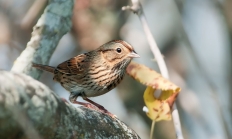
These lizards are found in open desert shrublands, particularly where islands of sand have accumulated around shrubs and are absent where a dense grass understory would inhibit their ability to run. The Long-nosed leopard lizard eats large insects, such as grasshoppers, crickets, and beetles, and also takes small vertebrates, including pocket mice, side-blotched lizards, whiptails, and Western fence lizards. Some plant material (flowers, berries) is eaten when available. Photo by Charlotte Ganskopp

When a turkey is shot in the head with a shotgun, death is usually instant. However, a turkey may flop on the ground for several seconds, even up to a minute, after it’s “dead.” In this case, the turkey isn’t going anywhere so simply wait for it to go still. If the bird is wounded and laying with its head up, you may need to shoot it again – in the head with a shotgun, or in the spine or vitals with an arrow. Don’t try to ring the neck of a bird that’s still alive but not going anywhere


The House sparrow is an invasive species introduced from Europe. No other North American wild bird is so associated with human settlement as this introduced House sparrow. Its foods are nearly all imports, and its nesting and cover requirements are also human-derived. The House sparrow and European starling are the only introduced passerine birds that are thriving in Oregon. These birds can dominate bird feeders and utilize nest boxes that were intended for native species. The House sparrow can be found statewide around buildings at human developments of adequate size ranging from scattered farmsteads in remote and rural areas to

Wide open spaces generally surround these sparrow-sized, ground dwelling birds. The upperparts are mostly brownish and the underparts are generally buffy with varying amounts of yellow on the throat. There is black on the breast and side of the head, but the most unique features are small black "horns." Females and immature birds are duller. Interesting behavior includes aerial displays and "flight songs" during courtship, and the propensity to forage and loaf along dirt and gravel roads. In western Oregon, it breeds in small, scattered populations throughout the Willamette Valley, with concentrations in the central valley on and near Basket
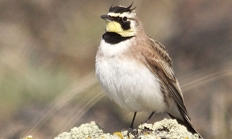
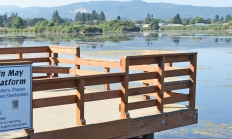
Features: These fish have dark blue backs, silver sides and bellies, and very long pectoral (side) fins. Albacore caught off the Pacific Coast are generally 21 to 30 inches long with the largest fish running about 35 pounds. Habitat: Tuna are pelagic species, meaning they spend their lives in the open ocean. Albacore generally show up 15-200 miles or more off the Pacific Coast in mid-July and stick around through September. Albacore are usually found where surface water temperatures are at least 59 degrees Fahrenheit and the water has a distinct clear blue color (this is where chlorophyll levels are
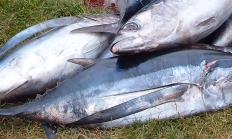
Few birds are as astonishing as the American dipper. This nondescript, dark brown to gray bird is seldom seen more than a few feet from the water's edge. Its elaborate song, which can come forth even on cold winter days, is readily heard above the noise of rushing streams. This bird's ability to dive into a rushing stream to forage on aquatic invertebrates and reappear in the same location has elicited wonder and excitement from ornithologists, naturalists, and birders as well as envy and adoration from fly-fishers. It is an uncommon year-round resident in montane streams and rivers throughout Oregon

Features: Brook trout are easily identified by the worm-like pale yellow markings on their backs and red dots with blue halos and white borders on their lower fins. In small streams brook trout are often 5- to 7-inches long but can reach 25 inches or more in large rivers or lakes. Habitat: Brook trout are an introduced species, first stocked in the early 1900s. They are widely distributed from high mountain lakes to headwater tributaries, and thrive in cold, mountainous streams and lakes where other species are unable to do well. Many barren lakes have been stocked with brook trout

The Common nighthawk is a migrant to Oregon with one of the longest migration distances of any North American bird. It is also one of the last to arrive in Oregon. Long, slender wings are marked by a white patch on the "hand" visible in flight from great distances. When perched on the ground, the cryptic brown, gray, and black mottling makes the bird almost invisible. This bird breeds and migrates at all elevations through the state. Its nesting habitat is characterized by open landscapes with little ground cover and is most abundant in sagebrush and rocky scablands and rimrock

Mouth calls, also known as diaphragm calls, can seem intimidating but they have some advantages over other kinds of calls. Mouth calls are popular with Oregon turkey hunters because: They're easier to keep dry during wet, spring seasons than are box or slate calls. Since the the call is in your mouth, you can call in a turkey without moving and possible spooking the bird. With practice, they can produce very realistic turkey sounds. Parts of a mouth call There are four parts to a mouth call. Starting at the outside of the call there’s: The tape. The tape stops

These birds are intelligent, curious, social and have good memories. Members of this group are commonly called the crow family, and are the among the most intelligent birds studied so far.
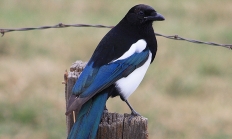
Nick Myatt, Region Manager Golden eagle research in northeast District wildlife staff in Wallowa County, in partnership with the U.S. Fish and Wildlife Service and the Nature Conservancy, began a pilot project to study the survival, movement, and reproductive success of golden eagles. During the pilot phase, ODFW staff tested methods of capture as well as telemetry units to determine feasibility for a longer-term study. The first capture event during this pilot project took place in mid-December 2024. USFWS provided four GPS units for this pilot year. The data from golden eagles captured in northeast Oregon during this pilot phase

One of the most familiar sights along the roads of Oregon is a Red-tailed hawk soaring high on the sky over a field, or perched on a utility pole, waiting patiently for prey. Red-tailed hawks are large-bodied raptors with relatively broad wings. The back is mottled brown, and the tail of mature birds is orangish red with a thin, dark subterminal band. Perched birds can be identified from behind even when the tail is concealed by the white mottling on the scapulars forming a faint 'V'. Most individuals can be assigned to one of two color morphs, light or dark

Features: Sacramento perch are blackish above with about seven vertical dark bars that are irregular in form and position. They are not a true perch, but a sunfish. It is the only member of the sunfish family native to the west coast and, in Oregon, is found only in the Klamath Basin. Sacramento perch are distinguished from the other sunfish in Oregon by having 12 or 13 dorsal fin spines whereas all the others have 10 or fewer. Maximum size in Oregon is about 12-inches in length and a weight of about 3/4 pound, although in California they have been

World famous for its loud, persistent singing and mimic abilities, the Mockingbird is highly conspicuous. The white flashes in the wings and tail of this grayish bird identify it in flight. It is primarily a southern species that has, by taking advantage of the environmental changes brought about by the ever-increasing human population, expanded its range northward in recent years. In many parts of the country it is a familiar bird of residential neighborhoods. Hear the call of the Northern mockingbird Photo by ©Keith Kohl, ODFW

